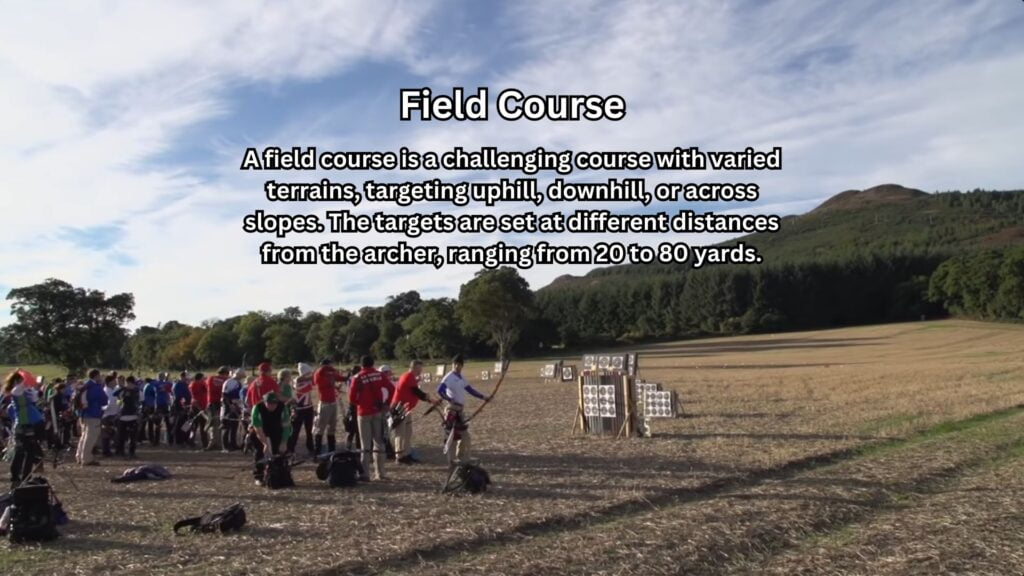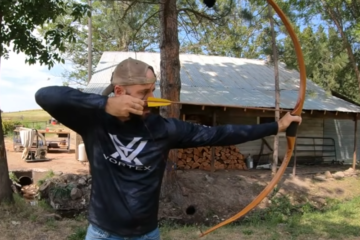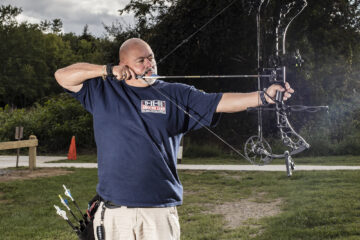Field archery courses are laid out through natural terrain and involve shooting at targets at varying distances. Scoring systems vary based on course difficulty and target size.
Field archery is a popular form of archery where courses are laid out through natural terrain, rather than on a flat range. In field archery, archers shoot at targets at unknown distances and varying terrain, simulating real-life hunting scenarios. The target faces, which are often three-dimensional, are set at different distances, and the archer must judge the distance and adjust their aim accordingly.
There are different scoring systems for field archery, with the most common being a 5-point system for the inner ring, 4 points for the second, and 3 points for the third. The scoring system varies based on the course’s difficulty and the target size. In this article, we will explore field archery courses and scoring systems.
Types Of Field Archery Courses
Exploring Field Archery: Courses And Scoring Systems
Field archery is an outdoor sport where archers shoot at a set of targets on different courses with varying distances and terrains. We’ll explore the different types of field archery courses and their scoring systems.
Field Course
A field course is a challenging course with varied terrains, targeting uphill, downhill, or across slopes. The targets are set at different distances from the archer, ranging from 20 to 80 yards.

- Terrain and target placement:
- The course has different sections with varying terrains such as open fields, woods, and hills.
- The targets are placed at varying heights and angles to challenge the archer’s abilities.
- Number of targets:
- A field course typically consists of 24 targets, with each target depending on the terrain and their placement.
- Scoring system:
- The scoring for field courses is based on a 5-point system, where each target has three scoring zones, the outer ring with a score of 3, the middle ring with a score of 4, and the inner ring with a score of 5.
Hunter Course
The hunter course is similar to the field course, but the targets are camouflaged to blend in with the surroundings, testing an archer’s ability to spot their targets.
- Target placement:
- The targets are placed at varying distances and heights, and all the targets are camouflaged to blend in with nature.
- Scoring system:
- In the hunter course, the scoring system is based on the same 5-point system used in the field course.
Animal Course
An animal course is a field course with 3d animal targets made of foam or other materials, imitating different animals such as deer, bear, or coyotes.
- Animal targets:
- The targets are life-sized, placed at varying distances and angles, and placed in natural settings.
- Scoring system:
- The scoring for animal courses is based on vital areas on the 3d targets, such as heart, lungs, or kill zone, with each area having a different score ranging from 5 to 20 points.
Field archery offers different types of courses, each with unique challenges and scoring systems. Whether you prefer aiming at regular targets or animal replicas, there’s always a field archery course that suits your preference.
Scoring Systems In Field Archery
Exploring Field Archery: Courses And Scoring Systems
Field archery is a challenging and exciting sport that involves shooting arrows at targets placed at various distances and elevations. To compete in field archery, you need to know about the different courses and scoring systems. In this blog post, we’ll explore scoring systems in field archery.
Traditional Scoring System
The traditional scoring system is the simplest and most straightforward system used in field archery. In this system, archers shoot arrows at a target with multiple concentric rings, and each ring represents a specific score. The rings closer to the center score higher points, while the outer rings score fewer points.
Scoring Zones
Scoring zones are the areas of the target that correspond to a specific score. In the traditional scoring system, the target has multiple rings, and each ring has a different score. Archers need to aim for the center of the target to score the most points.
Point System
In the point system, each shot is awarded a specific number of points based on the distance from the center of the target. In this system, the outer circles of the target have a higher point value than the inner circles.
3D Animal Target Scoring
3d animal target scoring involves shooting arrows at three-dimensional animal targets. These targets simulate real hunting situations, and archers need to aim for specific parts of the animal to score points. The specific areas of the animal that correspond to a score are outlined in the scoring system.
Different Shot Zones
Different shot zones are areas of the target that provide different scores, depending on where the archer hits the target. In this system, archers need to aim for specific areas of the target to score maximum points.
Mckenzie Scoring
Mckenzie scoring is a variation of the traditional scoring system that uses a more precise scoring method. In this system, each scoring zone is worth a specific number of points regardless of its position on the target.
Shot Placement
Shot placement involves aiming for specific parts of the target to score points. Archers need to hit designated areas to score the most points possible. In 3d animal target scoring, the animal’s vital organs are the highest-scoring areas.
Scoring System
Scoring system in field archery is an essential component of the sport. Archers need to master the different systems to score points accurately and win competitions. From the traditional scoring system to the point system, archers need to understand the key differences between each system to take their skill to the next level.
Understanding the different scoring systems in field archery is crucial for mastering the sport. From traditional scoring to McKenzie scoring, it’s essential to learn how to hit each target to score the most points. With practice, you can improve your technique and shoot your way to victory.
Importance Of Safety In Field Archery
Field archery is a fun and exciting activity enjoyed by many archery enthusiasts. The sport involves challenging courses that require a participant to shoot arrows at targets while navigating through different terrains. As thrilling as it may be, safety is crucial in field archery.
Safety Guidelines For Field Archery Courses:
The following are some safety guidelines that are crucial when participating in field archery courses:
- Always inspect the equipment before use, including the bow, arrows, and other gear. Make sure they are in good condition and functioning correctly.
- Keep your bow pointed downrange at all times. Avoid pointing it at any other person, even if it is not loaded.
- Be aware of your surroundings whenever you are on the course. Take note of other participants and their locations, and be mindful of your own position to avoid any accidents.
- Be sure to wear protective gear such as a chest guard, arm guard, and finger tabs. These will help to protect you from any potential injuries.
- Do not shoot arrows that miss the target or hit the ground.
- Do not retrieve the arrows when anyone is still on the field, as this can be dangerous.
Rules And Regulations:
Archery is a sport that comes with strict rules and regulations that each participant must adhere to. These rules are put in place to ensure the safety of the participants and to prevent any accidents. Some of the most important rules include:
- Always follow the instructions of the range operator or instructor.
- No running or horseplay is allowed on the field.
- Respect other participants, the range, and the environment.
- Do not consume alcohol or drugs before or during the activity.
Equipment Safety Measures:
Field archery requires specific equipment to ensure the safety of the participant and others. Some equipment safety measures include:
- Always use the correct arrows that match the draw weight of your bow.
- Use quality bowstrings and cables that are correctly installed and maintained.
- Ensure your bow has an appropriate draw weight that matches your strength and skill level.
- It is crucial to use a release aid to avoid injuring your hand and fingers.
Safety is a vital aspect to keep in mind when participating in field archery. Whether you are a beginner or a seasoned veteran, it is crucial to follow all safety guidelines and rules at all times to avoid any accidents or injuries.
Happy shooting!
Techniques And Tips For Field Archery
Field archery is a great outdoor activity that requires focus, skill, and patience. It is an excellent way to improve your archery skills and enjoy the great outdoors. Whether you are a seasoned pro or just starting, this guide will provide techniques and tips for field archery.
Shooting Techniques
Shooting techniques are critical for improving your accuracy and consistency on the field. Below are some key points to keep in mind:
- Stance: Stand with your feet shoulder-width apart, perpendicular to the target.
- Draw: Use your back muscles to draw the bowstring back to your anchor point.
- Aim: Keep your focus on the target while maintaining a steady hand.
- Release: Release the bowstring by relaxing your fingers in a smooth motion.
Tips For Improving Accuracy
Here are some recommendations to improve your accuracy:
- Practice: Practice regularly at different ranges and in various environmental conditions.
- Mindset: Focus on your breathing, visualize the target, and stay relaxed.
- Equipment adjustments: Make necessary adjustments, such as changing the arrow weight, bow sight, or draw weight, to improve your accuracy.
With these tips, you’ll be able to improve your shot accuracy, consistency, and overall field archery performance. So, grab your bow, head outdoors, and start mastering these techniques today!
Frequently Asked Questions
What Is Field Archery?
Field archery is a form of archery where targets are set up in a natural setting such as a wooded area or fields, with targets set at varying distances. The course consists of three types of target faces, each with its own color ring scheme, and scoring varies depending on accuracy.
How Is Field Archery Scored?
Field archery is scored based on the number of arrows that hit the target and in which ring they hit. The archer gets the number of points on the target’s ring that their arrow is touching. Each target has its own scoring system with different colored rings.
What Are The Different Types Of Field Archery Targets?
There are three types of targets used in field archery: round, animal and 3d. Round targets are used for short distances, animal targets are used for medium distances, and 3d targets are used for longer distances for more realistic practice.
How Far Are The Targets In Field Archery?
In field archery, the targets are usually set at various distances ranging from 10 to 80 yards. The distance often varies from station to station to test the archer’s skill at different ranges, angles, and elevations. Field archery is about navigating the course and adjusting distance and angle to hit the target.
What Equipment Is Needed For Field Archery?
To participate in field archery, you will need a bow, arrows, quiver, arm guard, finger tab or glove, and a release aid or sight depending on your preference. There are many types of bows and arrows to suit every kind of archer, from traditional wooden bows to modern compound bows.
Conclusion
As we explored in this article, field archery is a challenging and exciting sport that requires precision, patience, and skill. With various courses and scoring systems available, archers can test their abilities and have fun in the great outdoors. Whether you are a beginner or a seasoned archer, It can offer something for everyone.
Remember to always prioritize safety and respect for nature while practicing this unique sport. With practice and dedication, anyone can improve their skills and enjoy the community that surrounds field archery. So, grab your bow, choose a course, and let the arrows fly!







